Doug Cook's Blog, page 31
December 28, 2012
Training with Gyoo Hyun Lee
by Master Doug Cook
article appeared in Totally Taekwondo Magazine issue #46
 Paging through the Kukkiwon Textbook many years ago, a comprehensive volume originally published in 1975, I took notice of a severe looking martial artist chosen to model the technical attributes of taekwondo by virtue of his long experience and skilled attention to the art. Again, in 1998, this accepted standard-bearer recognized for his extraordinary acumen, would appear in a promotional video produced by the Organizing Committee for Taekwondo Korea 2000 as a staff instructor. Seeing who I eventually came to know as Grandmaster Gyoo Hyun Lee in motion rather than on the printed page, convinced me all the more that I would someday seek out his instruction.
Paging through the Kukkiwon Textbook many years ago, a comprehensive volume originally published in 1975, I took notice of a severe looking martial artist chosen to model the technical attributes of taekwondo by virtue of his long experience and skilled attention to the art. Again, in 1998, this accepted standard-bearer recognized for his extraordinary acumen, would appear in a promotional video produced by the Organizing Committee for Taekwondo Korea 2000 as a staff instructor. Seeing who I eventually came to know as Grandmaster Gyoo Hyun Lee in motion rather than on the printed page, convinced me all the more that I would someday seek out his instruction.
As destiny would have it, this was more difficult than expected. In planning the 1999 Chosun Taekwondo Academy Korea Training & Cultural Tour partially sponsored by the Committee, I inquired if Grandmaster Lee would be one of our teachers as advertised, but was informed that his schedule did not coincide with our visit. Likewise, in the initial planning stages of our 2004 tour, I once more requested his talents directly; “Unavailable” was the response from Korea and so, disappointedly, I turned my gaze elsewhere. Then, a few short weeks before departure, I received a surprise email from our travel service stating that the grandmaster had accepted our group provided we allow his senior instructors to assist. Naturally, rather than a condition, this stipulation amounted to a bonus. Since then, I would not consider developing an itinerary without including a day of training with Grandmaster Lee. To read entire article, subscribe to Totally Taekwondo Magazine
article appeared in Totally Taekwondo Magazine issue #46
 Paging through the Kukkiwon Textbook many years ago, a comprehensive volume originally published in 1975, I took notice of a severe looking martial artist chosen to model the technical attributes of taekwondo by virtue of his long experience and skilled attention to the art. Again, in 1998, this accepted standard-bearer recognized for his extraordinary acumen, would appear in a promotional video produced by the Organizing Committee for Taekwondo Korea 2000 as a staff instructor. Seeing who I eventually came to know as Grandmaster Gyoo Hyun Lee in motion rather than on the printed page, convinced me all the more that I would someday seek out his instruction.
Paging through the Kukkiwon Textbook many years ago, a comprehensive volume originally published in 1975, I took notice of a severe looking martial artist chosen to model the technical attributes of taekwondo by virtue of his long experience and skilled attention to the art. Again, in 1998, this accepted standard-bearer recognized for his extraordinary acumen, would appear in a promotional video produced by the Organizing Committee for Taekwondo Korea 2000 as a staff instructor. Seeing who I eventually came to know as Grandmaster Gyoo Hyun Lee in motion rather than on the printed page, convinced me all the more that I would someday seek out his instruction. As destiny would have it, this was more difficult than expected. In planning the 1999 Chosun Taekwondo Academy Korea Training & Cultural Tour partially sponsored by the Committee, I inquired if Grandmaster Lee would be one of our teachers as advertised, but was informed that his schedule did not coincide with our visit. Likewise, in the initial planning stages of our 2004 tour, I once more requested his talents directly; “Unavailable” was the response from Korea and so, disappointedly, I turned my gaze elsewhere. Then, a few short weeks before departure, I received a surprise email from our travel service stating that the grandmaster had accepted our group provided we allow his senior instructors to assist. Naturally, rather than a condition, this stipulation amounted to a bonus. Since then, I would not consider developing an itinerary without including a day of training with Grandmaster Lee. To read entire article, subscribe to Totally Taekwondo Magazine
Published on December 28, 2012 11:12
‘It is a privilege' | Warwick Greenwood Lake NY | Letters to the Editor
Read this heartfelt letter written to the Warwick Advertiser by Claire Gabelmann, Chairperson for the Warwick Lions Club Holiday party for Community Children in Need
"It is a privilege"
Published Dec 11, 2012 at 3:03 pm (Updated Dec 11, 2012)
For several years the students of the Chosun Taekwondo Academy in Warwick have been some of the strongest supporters of the Warwick Lions Club Holiday Project for Children in Need.
They held fund raisers all year long, such as book sales and coin drives, to raise $2,800 which was enough money to sponsor 37 of the 100 children who were served by this effort.
In addition, they purchased $400 of gift items which were used in the holiday “shop” where local children in need chose gift for their families. The students and their parents shopped for clothing, shoes and toys for 37 children.
On the night before the event, they donned elf hats to decorate the venue and set up the “shop.”
Read entire letter:‘It is a privilege' | Warwick Greenwood Lake NY | Letters to the Editor
"It is a privilege"
Published Dec 11, 2012 at 3:03 pm (Updated Dec 11, 2012)
For several years the students of the Chosun Taekwondo Academy in Warwick have been some of the strongest supporters of the Warwick Lions Club Holiday Project for Children in Need.
They held fund raisers all year long, such as book sales and coin drives, to raise $2,800 which was enough money to sponsor 37 of the 100 children who were served by this effort.
In addition, they purchased $400 of gift items which were used in the holiday “shop” where local children in need chose gift for their families. The students and their parents shopped for clothing, shoes and toys for 37 children.
On the night before the event, they donned elf hats to decorate the venue and set up the “shop.”
Read entire letter:‘It is a privilege' | Warwick Greenwood Lake NY | Letters to the Editor
Published on December 28, 2012 10:43
December 3, 2012
Chosun e-newsletter Archive Volumn 3 # 12 December 2012
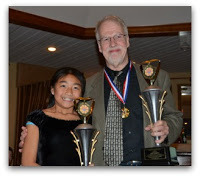 Dear Martial Arts Enthusiast,
Dear Martial Arts Enthusiast, Welcome to the December 2012 edition of the Chosun e-newsletter. The past few months have been some of the busiest on record at the Cho sun Taekwondo Academy . Highlights include the 2012 Chosun Korea Cultural and Training Tour, the USTA Seminar with Grandmaster Richard Chun and the inspiring bi-annual Black Belt Tests. The culmination of the year is our 15th Annual Chosun Taekwondo Academy Awards Banquet and Dinner Dance. As full of events as this year has been, the new year promises to be packed with exciting offerings as well. Read information below about upcoming overseas training opportunities, book releases and more.
Chosun wishes you and your family a safe and wonderful holiday season!
Kamsahamnida,
Patty Cook, Editor www.facebook.com/chosuntkd
Merry Christmas, Happy Hanukkah and Happy New Year
Read the entire newsletter...
sign-up for FREE monthly Chosun newsletter on our homepage
Published on December 03, 2012 07:00
November 4, 2012
Chosun e-newsletter Archive Volumn #3 November, 2012
Dojang News and Events
15th Annual Chosun Taekwondo Academy
Awards Banquet & Dinner Dance
Saturday, December 1, 2012 6:30 - 11:00pm
Black Bear Golf Club
138 Route 23 North, Franklin, NJ 07416
Adults - $49 Children(5-10 years) - $39 Children under 4 years-FREE
Make Checks payable and remit to Chosun Taekwondo Academy
Reserved seating for all: Contact Mary Suleski for seating preference: md2065@columbia.edu
DJ and dancing, cash bar, awards presentation, and a visit from Santa
Join us for a fun-filled family evening celebrating the Holiday Season! Kamsahamnida,
Patty Cook, Editor www.facebook.com/chosuntkd Stay Connected... Like us on facebook
Like us on facebook
Happy Thanksgiving
Happy"Chusok"(KoreanThanksgiving)
Chosun Taekwondo Academy Celebrating 15 Years! Read entire newsletter...
15th Annual Chosun Taekwondo Academy
Awards Banquet & Dinner Dance
Saturday, December 1, 2012 6:30 - 11:00pm
Black Bear Golf Club
138 Route 23 North, Franklin, NJ 07416
Adults - $49 Children(5-10 years) - $39 Children under 4 years-FREE
Make Checks payable and remit to Chosun Taekwondo Academy
Reserved seating for all: Contact Mary Suleski for seating preference: md2065@columbia.edu
DJ and dancing, cash bar, awards presentation, and a visit from Santa
Join us for a fun-filled family evening celebrating the Holiday Season! Kamsahamnida,
Patty Cook, Editor www.facebook.com/chosuntkd Stay Connected...
 Like us on facebook
Like us on facebook Happy Thanksgiving
Happy"Chusok"(KoreanThanksgiving)
Chosun Taekwondo Academy Celebrating 15 Years! Read entire newsletter...
Published on November 04, 2012 06:28
October 24, 2012
2014 Chosun Taekwondo Academy Korea Training & Cultural Tour
Annyung Haseyo Fellow Taekwondoists,
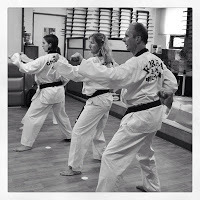 At one time or another almost every martial artist dreams of visiting the country from which their chosen discipline has evolved. To the karateka, that region is Okinawa; to the wushu practitioner, it is China. But, to the taekwondoist, it is a peninsula rich in greenery with mountains masked in swirling mists that rush to meet the sky. This enchanted land is called Korea: Land of the Morning Calm.
At one time or another almost every martial artist dreams of visiting the country from which their chosen discipline has evolved. To the karateka, that region is Okinawa; to the wushu practitioner, it is China. But, to the taekwondoist, it is a peninsula rich in greenery with mountains masked in swirling mists that rush to meet the sky. This enchanted land is called Korea: Land of the Morning Calm.In July of 2014 we are scheduled to participate in yet another extraordinary adventure that most only dream of – an adventure certain to be remembered for a lifetime. Your determination in bridging the gap between dream and reality is certain to result in cultural experiences, friendships, and technical insights that can only be gained through a direct exposure to Korea, taekwondo’s country of origin. Training at the various dojangs and meeting the many gifted masters and students of the art will to add color and meaning to your practice, now and in the future.
On this, the 2014 Chosun Taekwondo Academy Korea Training & Cultural Tour to take place from July 12th through July 20th, 2014, we are once again fortunate beyond measure to proceed with the oversight of martial arts legend, Grandmaster Richard Chun, 9th dan international master instructor, and president of the United States Taekwondo Association. Doors normally closed to Westerners open wide with Kwanjangnim’s assistance.
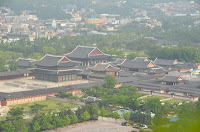 Furthermore, we will visit and train at the dojang of Grandmaster Gyoo Hyun Lee, the man responsible for maintaining technical accuracy in Kukkiwon formal exercises around the globe. Additionally, training sessions at the Kukkiwon – center of taekwondo operations worldwide, Keumgang Taekwondo Center with Master Ryan An, and at Gulgosa Temple high in mountains of Kyongju where we will practice traditional Korean Zen martial arts, are also scheduled.
Furthermore, we will visit and train at the dojang of Grandmaster Gyoo Hyun Lee, the man responsible for maintaining technical accuracy in Kukkiwon formal exercises around the globe. Additionally, training sessions at the Kukkiwon – center of taekwondo operations worldwide, Keumgang Taekwondo Center with Master Ryan An, and at Gulgosa Temple high in mountains of Kyongju where we will practice traditional Korean Zen martial arts, are also scheduled. Yet, one of the greatest attractions of this journey will be an excursion to Jeju Island off the southern tip of Korea. Here we will train at a local dojang and enjoy the distinctive landscape of this exotic province. Ultimately, however, the general practice of the national Korean martial art in its country of origin alone makes this trip an invaluable experience for all taekwondoists regardless of style, age or organizational affiliation.
Over the course of the past few months we have negotiated with our travel agency in order to secure a fair and reasonable price for our journey based on service, safety and reliability. Our estimated per-person cost of $3950, which may fluctuate due to fuel costs, includes the following:
· Roundtrip coach airfare to and from Korea and Jeju Island
· Double-occupancy lodging at major hotels*
· All meals
· English-speaking guides
· All training fees
· All admission fees to tourist attractions
· Transportation by motor coach while in Korea
*Room rates are based on double-occupancy, two people per room. Adding a person to a room will result in an additional cost. If you wish a single room, contact us and we will provide you with the cost.Costs not included in the aforementioned price:
· Tour warm-up suit with logo* ($125)
· Tour tee-shirts with logo* ($20 each)
· Bus transportation to and from airport (approx. $45 per person)
· Souvenirs, snacks, and free-time activities while in Korea
· Beverages other than water and tea at meals
· Cell phone rental in Korea if desirable
· Room/Airline upgrade
· Addition of person to room (single supplement)
*Purchase of warm-up suit and at least two tee shirts is mandatory since this will be your primary wear when not training and while traveling during our visit. Group photos will be taken with warm up suits on. Following an initial deposit of $1000, the remaining balance of $2950 per person will be paid in two equal payments of $1475, with a timeline to be specified shortly. If you are interested in joining us on this, our seventh training expedition to Korea, please contact us as soon as possible to announce your intention and reserve your space.
In closing, making this journey is certain to remove provincial boundaries from the mind and expand your overall worldview of the martial arts. The Korean people are extremely hospitable and it is a great honor to represent our country as ambassadors of taekwondo.
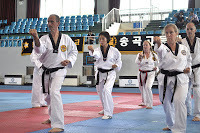 Finally, in today’s world of global uncertainty, feel secure in the knowledge that, in our own way, we will encourage a unity of spirit with citizens of a foreign land rather than division through ignorance. Stay focused, look forward to our day of departure, and train hard. I look forward to your enthusiastic reply! Tadani Kamsahamnida,
Finally, in today’s world of global uncertainty, feel secure in the knowledge that, in our own way, we will encourage a unity of spirit with citizens of a foreign land rather than division through ignorance. Stay focused, look forward to our day of departure, and train hard. I look forward to your enthusiastic reply! Tadani Kamsahamnida,Master Doug Cook
6th Dan / Kukkiwon Certification # 05910568Tour Administrator
info@chosuntkd.com
view our 2012 Korea Tour travelogue
Published on October 24, 2012 14:26
October 18, 2012
United States Taekwondo Association Eastern Regional Seminar with Grandmaster Richard Chun
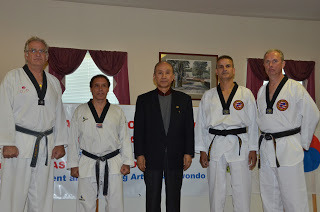 Grandmaster Richard Chun and USTA Master InstructorsWARWICK - The Chosun Taekwondo Academy, a traditional martial arts and hatha yoga center with headquarters in Warwick, NY, recently hosted the annual United States Taekwondo Association Eastern Regional Seminar at the Warwick Town Hall. The event featured classes in basic technique, self-defense, poomsae, sparring drills, and wood breaking taught by top USTA master instructors including martial arts pioneer Grandmaster Richard Chun. One hundred nineteen martial artists attended originating from thirteen area schools in three states, including Han Ho Martial Arts, National Martial Arts League, Byung Min Kim’s Taekwondo, Long Island Taekwondo Center, Success Martial Arts, Haddock Taekwondo Center, Evolution Martial Arts, Ultimate Martial Arts and the Chosun Taekwondo Academy.
Grandmaster Richard Chun and USTA Master InstructorsWARWICK - The Chosun Taekwondo Academy, a traditional martial arts and hatha yoga center with headquarters in Warwick, NY, recently hosted the annual United States Taekwondo Association Eastern Regional Seminar at the Warwick Town Hall. The event featured classes in basic technique, self-defense, poomsae, sparring drills, and wood breaking taught by top USTA master instructors including martial arts pioneer Grandmaster Richard Chun. One hundred nineteen martial artists attended originating from thirteen area schools in three states, including Han Ho Martial Arts, National Martial Arts League, Byung Min Kim’s Taekwondo, Long Island Taekwondo Center, Success Martial Arts, Haddock Taekwondo Center, Evolution Martial Arts, Ultimate Martial Arts and the Chosun Taekwondo Academy. Master Doug Cook, head instructor of the Chosun Taekwondo Academy stated, “We were delighted and honored to be given the opportunity to host an educational event of this magnitude in the enchanting surroundings of Warwick. Here, the participants improved their skills rather than using them to compete against one another as they would have in a tournament setting. Our school, and others in the USTA, took full advantage of this memorable occasion.”
In a separate statement, Grandmaster Richard Chun, a ninth-degree black belt, Olympic coach, and one of the highest ranking international master instructors in the United States, supported his decision in selecting the Chosun Taekwondo Academy to host the event by saying, “Master Cook’s school typifies the true spirit of taekwondo. His traditional curriculum, geared towards children and adults alike, not only stresses the physical aspects of the martial arts, but the mental and spiritual components as well. The Chosun Taekwondo Academy is one of the most active affiliates in the USTA and this is why I chose them for this honor.”
Published on October 18, 2012 08:37
September 28, 2012
Chosun e-newsletter Archive Volumn 3 #10 October, 2012
 NEW BOOK BY RICHARD CHUN
NEW BOOK BY RICHARD CHUN& DOUG COOK
Taekwondo Black Belt Poomsae -
Original Koryo and Koryo
Release Date: July 1, 2013YMAA Publications, Inc
Owing to the extensive reputation of Grandmaster Richard Chun as a modern day taekwondo pioneer and Master Doug Cook's prolific and award winning writing on the subject, this new book promises to be a landmark treatise for taekwondo practitioners worldwide.
Read entire newsletter
Published on September 28, 2012 15:22
September 27, 2012
Traditions Column by Master Doug Cook November Issue of TaeKwonDo Times Magazine
Not Everything Needs a Ball
Not long ago, my wife was speaking with the editor of our local newspaper regarding a recently submitted press release describing a public-service event hosted by the Chosun Taekwondo Academy Leadership Team, a group of young individuals who routinely engage in elevated training, provide community service on a regular basis, and utilize the virtues of tae kwon do as a vehicle to promote leadership skills.
During the course of the conversation, the editor praised the group for their tireless efforts in assisting the underprivileged and further recognized the fact that this was not the first time he had received such a bulletin publicizing our outreach program. Additionally, he was quick to note that local community leaders and citizens in concert take heed of the good deeds propagated by our students, all done with a minimum of fanfare.
Then the conversation took an interesting turn. While not coming out directly and saying so, he juxtaposed our group against various sports teams in the area whose primary mission is to dominate on the playing fields often at the cost of the very virtues supported by traditional tae kwon do training. While these entities often strive to stimulate charitable contributions as well, they do so obliquely without recognizing the noble engine that drives the process of compassion, and thus philanthropy, albeit in a benign manner. He then went on to summarize this notion by uttering the phrase “not everything needs a ball”. Given the huge popularity of varsity sports and the attention they are given by the local press, I was astonished by his comment.
At this point, I should mention that I personally have never been a sports enthusiast and, in truth, find many of the emotions elicited by such pastimes distasteful at best. By way of example, whether it be taekwondo as a sport, football or little league baseball, the unbridled actions of overzealous parents in distorted support of their offspring during the competitive process, frequently borders on riotous conduct. This atmosphere of behavior is not what we are attempting to cultivate in the traditional martial arts and to hear a man of erudition encapsulate this concept so succinctly was heartwarming indeed.
I am certain many readers will take exception with my point of view; especially those with children who participate in a variety of extra-curricular activities including those mentioned above. But it is the heritage of the Korean martial arts that stimulates the concept of giving back to ones community just as the ancient Hwarang warriors did when not occupied by battle. In my opinion, tae kwon do training undeniably represents nobility in motion. Every class is tempered with courtesy, humility, compassion and purpose. And for youngsters whose minds and hearts are uniquely open to suggestion, this is paramount.
Quite naturally, those unfamiliar with the discipline will argue, and understandably so, that tae kwon do resonates with aggression and violence, offering no socially-redeeming qualities whatsoever. And on the surface, this may be true. But if one were to take a closer look under the hood, milestones in the elevation of character will be revealed…all this minus the competitive mindset and barely masked hostility, often fostered under the guise of team sports.
As instructors of tae kwon do, we frequently say that “the only person you are competing against is yourself.” And for the most part, this is accurate effectively removing it from the fundamental doctrines of sport. Practitioners, of any age, sincerely seeking an enhanced lifestyle gradually alter longstanding habits of a questionable nature in favor of those that bolster integrity, compassion and discipline; traits that go hand in hand with cultivating an empathic worldview. Upon closer investigation, we see the long shadow cast by Confucianism on this process. Since traditional tae kwon do is influenced by the three Asian philosophical paradigms including Taoism, Buddhism and Confucianism, this is understandable.
Confucius, or more correctly K’ung Fu-tzu, espoused the cultivation of the “superior man”, one who is aware of his or her unique place in, and responsibility to, society at large. Furthermore, he taught that a single individual can influence world events through the simple projection of a benevolent state of mind. The Korean proverb, su shin je ga chi guk pyong chun fa, supports this philosophy. Loosely translated, this dictum states that, “peace within the individual brings peace within the family; peace in the family brings peace in the community; peace in the community, peace in the country and, ultimately, peace throughout the world.” As improbable as this may sound, there is little doubt that compassion towards fellow human beings goes a long way. Rather than being isolated in a vacuum, correct action ripples across humanity with much the same effect as would a pebble when dropped into a serene pool of water. Following this path leads the individual to develop a sense of purpose and harmony within the community.
Moreover, it should be remembered that the martial arts of the 21st century are significantly different from those practiced centuries ago. While self-defense remains the core purpose of practice, enrichment of character has evolved as a central theme as well. This metamorphosis began during the late 19thcentury with the creation of disciplines such as judo and karate-do by Gigoro Kano and Gichen Funakoshi respectfully. Martial arts intended to sustain a warrior on the field of battle became martial ways, or do, with the added benefit of building physical fitness, nationalism and morality in youngsters and college students alike. For the most part, with the exception of combat sport and MMA, this concept continues on today as the standard model in contemporary martial arts education. From this, it is not difficult to perceive the connection between a desire to improve the lives of others through community outreach and the virtuous tenets of traditional tae kwon do including courtesy, integrity, perseverance, self-control and indomitable spirit.
Lastly, while sport and all its trappings can provide an outlet for aggression and create social bonds by way of teambuilding, they all, by definition, are restricted to a set place and time. Meanwhile, the robust philosophical foundation that acted as a code of honor for the Hwarang continues to support traditional tae kwon do in the new millennium and remains as valid today as it was in the seventh century when these noble warriors sought moral wisdom beyond the zone of combat.
Ultimately, the modern martial artist, of whatever age, should not only be physically fit and adroit in the ways of self-defense, but in addition, become a beacon of strength and courage for family, friends and those less fortunate than he or she. By extension, enriching ones community through programs of systematic outreach, particularly by young practitioners, proves beyond a doubt that “not everything needs a ball” to provide a sense of self-worth coupled with community spirit. The above, amplified by an element of self-respect, is what it means to be a true modern day warrior clad in the armor of virtuous action, tailored by a earnest study of traditional tae kwon do.
Published on September 27, 2012 10:12
September 1, 2012
Chosun e-newsletter Archive Volumn #3 September, 2012
Dojang News and Events
Chosun Belt Promotion Test
Sunday August 19, 2012
The Chosun Summer Belt Promotion Test was the largest to date and was a testament to the perseverance it takes to be proficient in the art of taekwondo. From white to black belt, students demonstrated high levels of skill, technique and focus. Congratulations to all Chosun students. Special THANKS to Chosun instructors, Master Gary Stevens and Master Joseph Preira for officiating.
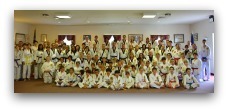 Click image for more photos
Click image for more photos
See a video Read entire newsletter
Chosun Belt Promotion Test
Sunday August 19, 2012
The Chosun Summer Belt Promotion Test was the largest to date and was a testament to the perseverance it takes to be proficient in the art of taekwondo. From white to black belt, students demonstrated high levels of skill, technique and focus. Congratulations to all Chosun students. Special THANKS to Chosun instructors, Master Gary Stevens and Master Joseph Preira for officiating.
 Click image for more photos
Click image for more photos
See a video Read entire newsletter
Published on September 01, 2012 08:17
August 30, 2012
TaeKwonDo Times Traditions Column by Master Doug Cook September, 2012
The Academics of Taekwondo
 Tae Kwon Do is composed of many components, most dominated by physical qualities. Front kicks, round kicks, side kicks, hand and aerial techniques abound, endowing the national Korean martial art with its unique character. Yet, as the discipline matured from its humble beginnings in the 1940s and 50s, it gained both complexity and academic dimensions until today, modern educational institutes of higher learning located in Korea offer Taekwondology, along with its comprehensive syllabus of technique, tradition, rules and regulations, as a major.
Tae Kwon Do is composed of many components, most dominated by physical qualities. Front kicks, round kicks, side kicks, hand and aerial techniques abound, endowing the national Korean martial art with its unique character. Yet, as the discipline matured from its humble beginnings in the 1940s and 50s, it gained both complexity and academic dimensions until today, modern educational institutes of higher learning located in Korea offer Taekwondology, along with its comprehensive syllabus of technique, tradition, rules and regulations, as a major.
Regardless of the fact that the roots of tae kwon do date back to antiquity, historians agree that the primordial forms of the art, then known as kong soo do, tang soo do and for a brief period of time, tae soo do, were heavily influenced by Okinawan karate-do coupled with Chinese chuan fa, Japanese judo and, to some degree, aikido and jujutsu. While in transition, ritual and practice fortifying the burgeoning discipline innocently drew breath from these styles.
Then, just as the citizenry of the Korean nation were giventhe opportunity to reestablish their cultural and technical infrastructure - admittedly after immeasurable strife and bloodshed - so too did tae kwon do. Rising like a phoenix from the ashes of war, the disparate styles that were to evolve into a single, standardized national treasure, took on its own identity within the pantheon of Asian combat disciplines. Distinctive skills and strategies featuring philosophical underpinnings exclusive to Korean culture clearly began to emerge during the latter part of the twentieth century. This process was not easy and came at great cost, both socially and politically, to many of its founders and the organizations they would come to create. Yet, today, tae kwon do stands tall as a battle-proven form of self-defense and a fully recognized Olympic sport boasting a growth curve second to none; all this is the span of a short sixty years. Miracles of this magnitude cannot be accomplished purely on a physical level. Rather, planning, forethought and the accumulation of knowledge must be converted into action; action stoked by the uncorrupted transmission of wisdom across generations. Lessons learned in battle during the Silla (57 BC-AD 935), Koryo (918-1392) and Chosun (1392-1910) dynasties, exemplified by warriors of the Hwarang and preserved by fighting Buddhist monks called on to defend the nation against Japanese invaders, are as valid today as they were then. Couple these tactics with a contemporary understanding of physiology, sports medicine and body mechanics, and a valid blueprint of academic standards begins to materialize. The academic approach to tae kwon do becomes abundantly clear as one sifts through the many editorial contributions offered by scholars, masters and enlightened practitioners dedicated to the worldwide proliferation of the art. Through the magic of the Internet, technique, decorum and training rituals have been exhaustively documented for current and future use. Books, treatises and dissertations have been written to intellectually support routines and principles. These, amplified by visual aids, amount to a supreme body of knowledge that can quite literally take a lifetime to absorb. Great men and women come to mind who have generously contributed to this paradigm of data - more than not, at little or no personal gain above that of serving the art. Highly qualified individuals such as Richard Chun, Sang Kyu Shim, Jane Hallander, Kyong Myong Lee, Son Duk Sung, Sihak Henry Cho, Stuart Anslow, TaeKwonDo Times columnist Karen Eden and Alex Gillis share this distinction with others too numerous to mention. And just what is being documented that justifies tae kwon do as a discipline worthy of academic pursuit? First and foremost, the technical catalog that defines the traditional Korean martial art. General Choi Hong Hi, a primary founder who created the International Taekwon-Do Federation in March of 1966, claimed an arsenal containing 3200 separate techniques, each with its own distinct purpose and method of execution, many depicted in his fifteen-volume Encyclopedia of Taekwon-Do. Similarly, an updated version of the Kukkiwon Textbook reissued in 2005 devotes over 700 pages to the proper articulation of technique. But wisdom accumulated over the decades does not stop there. Landmark works by Grandmaster Richard Chun and his contemporaries portray defacto training standards and procedures relied upon worldwide by hundreds of thousands of students. Moreover, since tae kwon do is recognized as a comprehensive form of self-defense with a pedigree reaching far back to the distant past, there are metaphysical and well as physical concepts to ponder. Exploring the use of meditation and ki, or internal energy development, as essential elements of the art demands research that can only be accomplished through the interrogation of Asian historical and, in some cases, medical records compiled centuries ago. Valid examples of these are the Yellow Emperor’s Inner Canon, a cornerstone of Traditional Chinese Medicine, coupled with the physical lessons posited by the Myue Dobo Tongji(Illustrated Manual of Korean Martial Arts), authored in 1790. Then, not to marginalize their significance, if one is to accrue an absolute understanding of any classical martial art, then it is equally essential to survey influential native customs, physiological concepts that power its engine and moral doctrines that govern its use. Many of these can be found in the teachings of Confucianism, Taoism and Buddhism. Clearly, taken as a whole the ingredients cited above compound to represent a body of academic knowledge profoundly worthy of transmission from one generation to the next. One only need embrace it. Naturally, as with any established sport, there exists a majority of practitioners who will exclusively participate for competitive purposes only. And because tae kwon do offers much in the way of physical fitness and athletic recognition on the collegiate, state, national and international level, and because just as a coin, it exhibits two sides, one representing the game and the other the art, this is entirely understandable. Yet it is important to recognize the difference between cultivating athletes and holistically-trained martial artists - practitioners who are not only proficient in the ring, but who wholeheartedly welcome knowledge concerning the vast mosaic that is traditional tae kwon do.

 Tae Kwon Do is composed of many components, most dominated by physical qualities. Front kicks, round kicks, side kicks, hand and aerial techniques abound, endowing the national Korean martial art with its unique character. Yet, as the discipline matured from its humble beginnings in the 1940s and 50s, it gained both complexity and academic dimensions until today, modern educational institutes of higher learning located in Korea offer Taekwondology, along with its comprehensive syllabus of technique, tradition, rules and regulations, as a major.
Tae Kwon Do is composed of many components, most dominated by physical qualities. Front kicks, round kicks, side kicks, hand and aerial techniques abound, endowing the national Korean martial art with its unique character. Yet, as the discipline matured from its humble beginnings in the 1940s and 50s, it gained both complexity and academic dimensions until today, modern educational institutes of higher learning located in Korea offer Taekwondology, along with its comprehensive syllabus of technique, tradition, rules and regulations, as a major. Regardless of the fact that the roots of tae kwon do date back to antiquity, historians agree that the primordial forms of the art, then known as kong soo do, tang soo do and for a brief period of time, tae soo do, were heavily influenced by Okinawan karate-do coupled with Chinese chuan fa, Japanese judo and, to some degree, aikido and jujutsu. While in transition, ritual and practice fortifying the burgeoning discipline innocently drew breath from these styles.
Then, just as the citizenry of the Korean nation were giventhe opportunity to reestablish their cultural and technical infrastructure - admittedly after immeasurable strife and bloodshed - so too did tae kwon do. Rising like a phoenix from the ashes of war, the disparate styles that were to evolve into a single, standardized national treasure, took on its own identity within the pantheon of Asian combat disciplines. Distinctive skills and strategies featuring philosophical underpinnings exclusive to Korean culture clearly began to emerge during the latter part of the twentieth century. This process was not easy and came at great cost, both socially and politically, to many of its founders and the organizations they would come to create. Yet, today, tae kwon do stands tall as a battle-proven form of self-defense and a fully recognized Olympic sport boasting a growth curve second to none; all this is the span of a short sixty years. Miracles of this magnitude cannot be accomplished purely on a physical level. Rather, planning, forethought and the accumulation of knowledge must be converted into action; action stoked by the uncorrupted transmission of wisdom across generations. Lessons learned in battle during the Silla (57 BC-AD 935), Koryo (918-1392) and Chosun (1392-1910) dynasties, exemplified by warriors of the Hwarang and preserved by fighting Buddhist monks called on to defend the nation against Japanese invaders, are as valid today as they were then. Couple these tactics with a contemporary understanding of physiology, sports medicine and body mechanics, and a valid blueprint of academic standards begins to materialize. The academic approach to tae kwon do becomes abundantly clear as one sifts through the many editorial contributions offered by scholars, masters and enlightened practitioners dedicated to the worldwide proliferation of the art. Through the magic of the Internet, technique, decorum and training rituals have been exhaustively documented for current and future use. Books, treatises and dissertations have been written to intellectually support routines and principles. These, amplified by visual aids, amount to a supreme body of knowledge that can quite literally take a lifetime to absorb. Great men and women come to mind who have generously contributed to this paradigm of data - more than not, at little or no personal gain above that of serving the art. Highly qualified individuals such as Richard Chun, Sang Kyu Shim, Jane Hallander, Kyong Myong Lee, Son Duk Sung, Sihak Henry Cho, Stuart Anslow, TaeKwonDo Times columnist Karen Eden and Alex Gillis share this distinction with others too numerous to mention. And just what is being documented that justifies tae kwon do as a discipline worthy of academic pursuit? First and foremost, the technical catalog that defines the traditional Korean martial art. General Choi Hong Hi, a primary founder who created the International Taekwon-Do Federation in March of 1966, claimed an arsenal containing 3200 separate techniques, each with its own distinct purpose and method of execution, many depicted in his fifteen-volume Encyclopedia of Taekwon-Do. Similarly, an updated version of the Kukkiwon Textbook reissued in 2005 devotes over 700 pages to the proper articulation of technique. But wisdom accumulated over the decades does not stop there. Landmark works by Grandmaster Richard Chun and his contemporaries portray defacto training standards and procedures relied upon worldwide by hundreds of thousands of students. Moreover, since tae kwon do is recognized as a comprehensive form of self-defense with a pedigree reaching far back to the distant past, there are metaphysical and well as physical concepts to ponder. Exploring the use of meditation and ki, or internal energy development, as essential elements of the art demands research that can only be accomplished through the interrogation of Asian historical and, in some cases, medical records compiled centuries ago. Valid examples of these are the Yellow Emperor’s Inner Canon, a cornerstone of Traditional Chinese Medicine, coupled with the physical lessons posited by the Myue Dobo Tongji(Illustrated Manual of Korean Martial Arts), authored in 1790. Then, not to marginalize their significance, if one is to accrue an absolute understanding of any classical martial art, then it is equally essential to survey influential native customs, physiological concepts that power its engine and moral doctrines that govern its use. Many of these can be found in the teachings of Confucianism, Taoism and Buddhism. Clearly, taken as a whole the ingredients cited above compound to represent a body of academic knowledge profoundly worthy of transmission from one generation to the next. One only need embrace it. Naturally, as with any established sport, there exists a majority of practitioners who will exclusively participate for competitive purposes only. And because tae kwon do offers much in the way of physical fitness and athletic recognition on the collegiate, state, national and international level, and because just as a coin, it exhibits two sides, one representing the game and the other the art, this is entirely understandable. Yet it is important to recognize the difference between cultivating athletes and holistically-trained martial artists - practitioners who are not only proficient in the ring, but who wholeheartedly welcome knowledge concerning the vast mosaic that is traditional tae kwon do.
Published on August 30, 2012 15:43



